包豪斯设计风格英文版
- 格式:ppt
- 大小:1.58 MB
- 文档页数:45
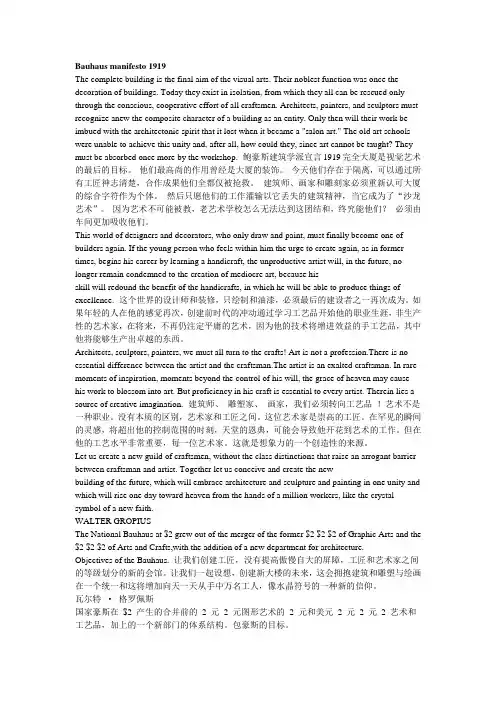
Bauhaus manifesto 1919The complete building is the final aim of the visual arts. Their noblest function was once the decoration of buildings. Today they exist in isolation, from which they all can be rescued only through the conscious, cooperative effort of all craftsmen. Architects, painters, and sculptors must recognize anew the composite character of a building as an entity. Only then will their work be imbued with the architectonic spirit that it lost when it became a "salon art." The old art schools were unable to achieve this unity and, after all, how could they, since art cannot be taught? They must be absorbed once more by the workshop.鲍豪斯建筑学派宣言1919完全大厦是视觉艺术的最后的目标。
他们最高尚的作用曾经是大厦的装饰。
今天他们存在于隔离,可以通过所有工匠神志清楚,合作成果他们全都仅被抢救。
建筑师、画家和雕刻家必须重新认可大厦的综合字符作为个体。
然后只愿他们的工作灌输以它丢失的建筑精神,当它成为了“沙龙艺术”。
因为艺术不可能被教,老艺术学校怎么无法达到这团结和,终究能他们?必须由车间更加吸收他们。

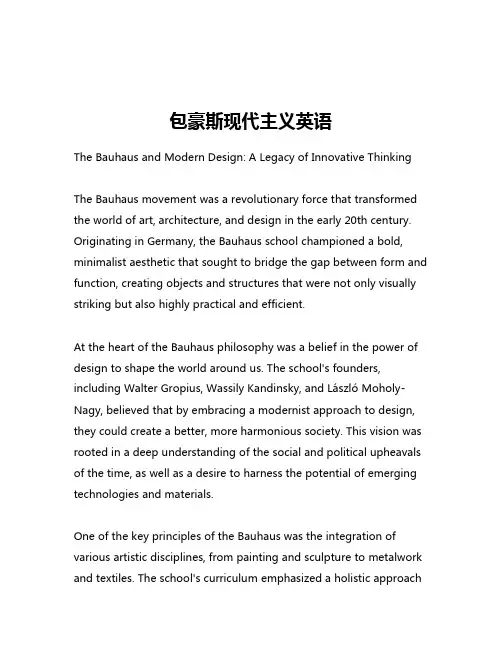
包豪斯现代主义英语The Bauhaus and Modern Design: A Legacy of Innovative ThinkingThe Bauhaus movement was a revolutionary force that transformed the world of art, architecture, and design in the early 20th century. Originating in Germany, the Bauhaus school championed a bold, minimalist aesthetic that sought to bridge the gap between form and function, creating objects and structures that were not only visually striking but also highly practical and efficient.At the heart of the Bauhaus philosophy was a belief in the power of design to shape the world around us. The school's founders, including Walter Gropius, Wassily Kandinsky, and László Moholy-Nagy, believed that by embracing a modernist approach to design, they could create a better, more harmonious society. This vision was rooted in a deep understanding of the social and political upheavals of the time, as well as a desire to harness the potential of emerging technologies and materials.One of the key principles of the Bauhaus was the integration of various artistic disciplines, from painting and sculpture to metalwork and textiles. The school's curriculum emphasized a holistic approachto design, encouraging students to experiment with a wide range of media and techniques. This interdisciplinary approach fostered a spirit of innovation and collaboration, as students and faculty worked together to push the boundaries of what was possible in the realm of design.The Bauhaus also placed a strong emphasis on functionality and practicality. Rather than creating art for art's sake, the school's designers focused on developing products and structures that were not only visually appealing but also served a practical purpose. This focus on utility and efficiency was a direct response to the industrialization and mass production that were transforming the world at the time, as the Bauhaus sought to create a new, more democratic approach to design that could be accessible to the masses.One of the most iconic examples of the Bauhaus aesthetic is the Bauhaus building in Dessau, designed by Walter Gropius in 1926. This striking structure, with its clean lines, expansive windows, and use of innovative materials like glass and steel, embodied the school's commitment to modernist principles. The building's design was not only aesthetically pleasing but also highly functional, with spaces that were designed to facilitate the school's interdisciplinary approach to learning and creating.The influence of the Bauhaus can be seen in countless aspects of modern design, from the sleek, minimalist furniture of Mies van der Rohe to the bold, geometric patterns of Anni Albers' textiles. The school's legacy can also be felt in the work of contemporary designers who continue to draw inspiration from the Bauhaus' commitment to innovation, functionality, and social responsibility.In the decades since the Bauhaus was forced to close its doors in 1933 due to political pressure from the Nazi regime, the school's ideas and principles have continued to shape the way we think about design and its role in shaping our world. The Bauhaus' emphasis on interdisciplinary collaboration, practical functionality, and social responsibility has become a touchstone for designers and architects who are committed to creating a better, more sustainable future.As we look to the future, it is clear that the Bauhaus' legacy will continue to be felt in the work of designers, architects, and artists who are dedicated to pushing the boundaries of what is possible. Whether through the creation of innovative new products, the design of sustainable buildings, or the exploration of new artistic mediums, the Bauhaus' spirit of innovation and social responsibility will continue to inspire and guide those who are committed to shaping a better world.。
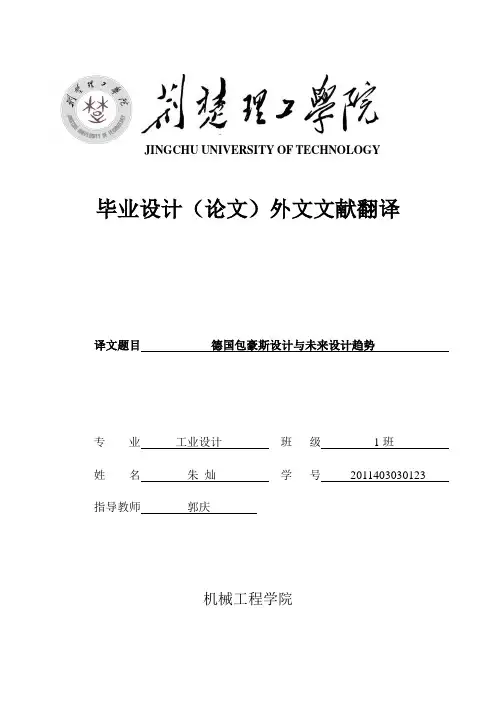
毕业设计(论文)外文文献翻译译文题目 德国包豪斯设计与未来设计趋势专 业 工业设计 班 级 1班 姓 名 朱 灿 学 号 2011403030123 指导教师 郭庆机械工程学院JINGCHU UNIVERSITY OF TECHNOLOGYGermany Bauhaus design and Future Design Trend【Abstract】German Bauhaus had a significant influence on the modern design education, meanwhile, it established the foundation of the leading position in the world for German industrial design. Through analyzing on current industrial design conditions from different countries, art design is considered as the main part of industrial design. This paper reviewed the last 10 years’ development of industrial design program in Zhejiang University of Science and Technology. The industrial design program have taken considerable achievements in many fields, such as the practice of Germany model, disciplines construction, teaching reform, manufactures & college cooperation, project teaching and design competitions. And You cannot ignore the industrial design ten trend 【Keywords】Bauhaus, industrial design, project teaching, practice ,10 Industrial Design Trends1. German Bauhaus and industrial designIn 1919, the Bauhaus school had been built in Weimar, Germany. This have been called the “cradle of world industrial design”, the milestone in the art design history. Bauhaus believed that the foremost thing is letting the students explore their own design ways, rather than just teaching them the teachers’ ways; developing students’ in dependent and critical thinking ability rather than imposing certain design styles on them. Compared with other design schools that had similar education philosophies, Bauhaus had distinctive education philosophy. It took thorough reform on the traditional art design education system and established art design as a new professional discipline. Meanwhile, Walter Gropius, the founder of Bauhaus made “Unity of art and technology” as the dominant design education philosophy.One of Bauhaus initiative works is purifying the forms of general industrial products. Bauhaus stressed that the product forms should be designed based on basic geometric patterns such as cubes, squares and circles. The product forms and outlines should be simple and varied in different way s and follow abstract form principles and aesthetics. Because Bauhaus’s brave and aggressive exploring and reform, it took significant key influence on the forming of Modernism Art Style and made the Bauhaus design a world-wide reputation. Therefore Bauhaus became the milestone of modern art design history.American artist Joseph Sinel first mentioned the term of Industrial design in 1919. However in China, until 1983, the Ministry of Education had conformed industrial design discipline as the sample major of general colleges. The original name of the major is “Product Forming” for art students. In 1998 the national major category had been adjusted to be integrated into the international conventions. The “Product forming” major had removed the focus from th e product forms to the area of researching the human-product-environment relationships. The name had been replaced by “Industrial design” and the major had been set for both engineering and art education schools.Bauhaus had many top European artists at that time, such as Itten, Kandinsky, and Klee etc. They are famous abstract painters. Their teaching cultivated the Bauhaus students and contributed to the 20’s century art design. Most of famous industrial designers such as Philippe Starck, Marc Newson and yves béhar are graduated from the art design schools. Their success proved that the art design education is effective for industrial design education. The product form design is still an important aspect in undergraduate industrial design studies and the industrial design is an important component of current famous art design schools.Royal College of Art Norwegian Institute of Art and Design University of Duisburg-Essen, Politecnico di Milano, Hannover University of Applied Sciences and Arts (FH Hannover), their industrial design departments are belong to art and design schools.America: According to a survey of IDSA (The Industrial Designers Society of America) in 1998, there are 49 institutes that have industrial design undergraduate or graduate programs registered in IDSA list. Typical industrial design majors usually are set in art schools, which can grant bachelor degree in fine arts or science. Most of them got the certification of NASAD (National Association of Schools of Art and Design). Only 15 in the 49 schools did not get the certification. IDSA declared that 5 years later, only the certified the industrial design majors can get be recognized. There are 37 industrial design majors in universities, 6 in design colleges, 4 in art schools. This situation did not vary in current years.Asia: In Japan, industrial design majors also set in art schools or independent industrial design faculties, such as Tokyo Zokei University, Musashino Art University, Tama Art University, and University of Tsukuba etc. In Hongkong, The Hong Kong Polytechnic University has famous industrial design programs. In Taiwan, Shih Chien University, National Cheng Kung University,National Yunlin University of Science & Technology have famous industrial design programs. In mainland of China, Jiangnan University, Tsinghua University, Hunan University, Tongji University and the Guangzhou academic of fine arts all have their industrial design departments in the art design schools or departments.2 .10 Industrial Design Trends You Can't Ignore2.1Design For A CauseCompanies including Herman Miller and American Apparel are promoting their ideals through design. Yves Béhar's leaf lamp for Herman Miller (shown) uses a biomorphic grid of LEDs, which consume 40% percent less energy than fluorescent lights and last for 100,000 hours. And Nike plans to make its entire footwear line out of sustainable materials by 2010.2.2SimplexitySteve McCallion, executive creative director of Portland, Ore.-based industrial design firm Ziba Design, says there's a trend toward "simplexity," products that have many functions but are approachable, ergonomically correct and easy to use--like Apple's iPhone. The baby boomers have also propelled simplexity; as the generation ages, the need for easy-to-use, at-home medical equipment becomes greater. Ami Verhalen, director of industrial design at Madison, Wis.-based Design Concepts, says that in-home health care will be a huge driver for product innovation in theupcoming decade.2.3PersonalizationFrom Nike ID shoes to Build-a-Bear teddies, retailers are adding a "build your own" element to brands. Do it yourself--or DIY--serves as an important element of this trend. Publications like Ready Made magazine and books like designer Wendy Mullin's Sew U encourage consumers to put their own spin on things.2.4GlobalizationLike other industries, outsourcing has affected international design. Today a designer in Delhi might be working with a manufacturer in Columbus. Steve McCallion says that the globalization of product design has created Internet communities that enable more people to participate in the design process. Companies like Kid Robot can employ toy designers from Tokyo to Tucson with greater ease than ever.2.5OrnamentationIn fashion design, we're seeing a return to minimalism, but in home decor, ornate details are in fashion. For the first time in decades, wallpaper is in fashion, and the details are rich--brocades, velvets and jewel-tone colors. Long-forgotten textile designers like Florence Broadhurst and Vera Neumann are receiving attention from a new generation of design-savvy consumers.2.6Polarization Of DesignBig-box or luxury retailer? Many experts say that design has been polarized, with innovative products available at both the very high end (Neiman Marcus, Moss) and the very low end (Target, Ikea). Meanwhile, midrange retailers like Macy's suffer from lack of fresh, on-trend ideas. That isolates the huge chunk of the population that can afford something higher-end than the $200 Malm bed at Ikea but scoff at the price of a $16,000 Hastens mattress.2.7Pink DesignGadgets are a guy's game, right? Not if you consider the latest products with feminine mystique. Motorola released a lipstick pink Razr cellphone, and more recently, LG released a Prada phone. More and more manufacturers are creating sleeker, feminized versions of their clunky, chunky products, and both men and women are biting. Want proof of the feminization of product design? Just check out , which rates several items a day as "Geek chic" or "Just Plain Geeky."2.8Mass ImperfectionSome designers are creating intentionally flawed pieces, like designer Jason Miller's duct tape chair or Bodum's Pavina glassware collection, which uses mouth-blown double-walled glass, giving each piece a slight variation in height, thickness and weight. Whiskered and weathered textiles--on denim as well as furniture and tapestries--are more recognizable examples of intentional imperfection in production.2.9CraftAs mass retailers like Target become more design-focused, there's a countertrend of independent manufacturers and designers creating one-off, heirloom pieces. Where to find these limited-edition treasures? Artisan e-commerce sites like , classical craft companies like Heath Ceramics and modernist design houses such as Design Within Reach.2.10Focus On The Other 90%Anthony Pannozzo, vice president of design strategy at Waltham, Mass.-based firm Herbst LaZar Bell, says that well-designed products are available to only 10% of the world's population. However, more and more designers are starting to cater to consumers in Africa, Asia and Latin America.【References】[1] S Z Wang. “A History of Modern Design”, China Youth Press, Beijing, 2002[2] D.S. Yang. “A Discussion of The Differences in Industrial Design Education between China and Germany from th e Workshop Project Practice”, Journal of Hefei University (Natural Sciences), 2006:21-22[3] Rosson M.B, J.M.Carroll. “Usability Engineering: Scenario-Based Development of Human-Computer Interaction”, San Francisco:Morgan Kaufmann, 2002[4] Kevin N. Otto, Kristin L Wood. “Product Design: Techniques in Reverse Engineering and New Product Development”, Tsinghua University Press, Beijing, 2003[5]《industrial design history》Herenke Beijing Institute of Technology Press[6]《The modern history of design》Wangshouzhi China Youth Press[7]《Product System Design》Wuxiang China Light Industry Press[8]《Design of products》magazine[9] L. Axon, K. Garry etc.,An Evaluation of CFD for Modeling the Flow Around Stationary and Rotating Isolated Wheel, SAE 980034[10] N. Horinouchi, Y. Kato etc., Numerical Investigation of V ehicle Aerodynamics with Overlaid Grid System, SAE 950628[11] U. B. Mehta, Some Aspects of Uncertainty in Computational Fluid Dynamics Results, Journal of Fluids Engineering Transactions of the ASME, Dec. 1991, V ol. 113, pp538 - 543[12] STAR-CD User Guide Version 3.10, Computational Dynamics Limited 1999[13] STAR-CD Tutorial Manual V ol. 1 Tutorial 1 ~ Tutorial 7 Version 3.10, Computational Dynamics【中文翻译】德国包豪斯设计与未来设计趋势摘要德国包豪斯有显著的影响,与此同时,现代设计教育奠定了基础,它处于世界领先地位的德国工业设计。


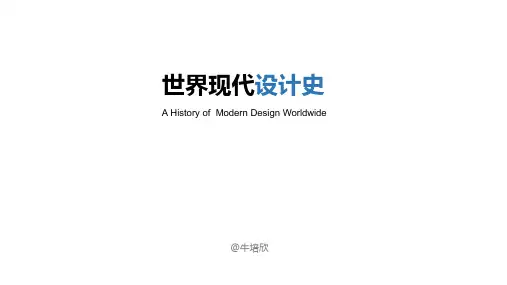



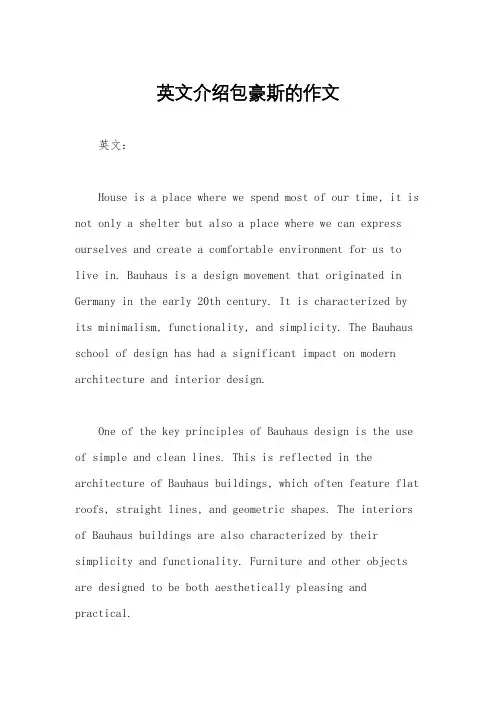
英文介绍包豪斯的作文英文:House is a place where we spend most of our time, it is not only a shelter but also a place where we can express ourselves and create a comfortable environment for us to live in. Bauhaus is a design movement that originated in Germany in the early 20th century. It is characterized by its minimalism, functionality, and simplicity. The Bauhaus school of design has had a significant impact on modern architecture and interior design.One of the key principles of Bauhaus design is the use of simple and clean lines. This is reflected in the architecture of Bauhaus buildings, which often feature flat roofs, straight lines, and geometric shapes. The interiors of Bauhaus buildings are also characterized by their simplicity and functionality. Furniture and other objects are designed to be both aesthetically pleasing and practical.Another important aspect of Bauhaus design is the use of modern materials and technology. Bauhaus architects and designers were at the forefront of using new materials such as concrete, steel, and glass. They also embraced new technologies such as electric lighting and central heating.Bauhaus design has had a lasting impact on modern architecture and interior design. Many contemporary buildings and interiors are still influenced by the principles of Bauhaus design. For example, the Apple store in New York City's Fifth Avenue is a modern interpretation of Bauhaus design. The store features a minimalist interior with clean lines and simple shapes.中文:房子是我们大部分时间都在的地方,它不仅是一个庇护所,还是我们可以表达自己、创造舒适环境的地方。
BauhausThe Bauhaus is the best-known school of art,design and architecture of the twentiethcentury. Among its staff and students wereleading pioneers of early modernism in allareas of the arts and crafts, and the impact oftheir work and ideas has been felt in Europeand the United States for many years.Intended to represent a fresh start afterWorld War I, the school opened in 1919 underthe direction of the architect Walter Gropius, inthe buildings of the Weimar Academy of Art.In 1925 it moved to Dessau, a city withstronger industrial links, in new buildingsdesigned by Gropius. After being closed by thegovernment, the Bauhaus, now under Mies vander Rohe, operated in Berlin in 1932-3, until itwas closed once again by the Nazis.Extending the thinking of leading figures inthe Arts and Crafts movement in Britain suchas William Morris, C.R. Ashbee and W.R.Lethaby, Gropius hoped to reunite the fine and applied arts in the aftermath of the war. He attracted an impressive range of established artists to form the initial staff, including Wassily Kandinsky, Lyonel Feininger and Paul Klee(once a member of Der Blaue Reiter). Although these teachers were not architects, the school's aim was that all students should graduate in architecture, for it was believed that this discipline encapsulated(囊括) all other areas of art and design: In their first year students pursued the Vorkurs(预备课程), or foundation course, after which they studied in a workshop dedicated to materials, investigating wood, metal, weaving, ceramics and printing. In fact many graduated as designers in these fields rather than in architecture.The foundation course, taught initially by Jahannes Itten, then Laszlo Moholy-Nagy after 1923, was crucial in establishing a common approach among the students. Emphasis was placed on examining the formal and physical properties(特征) of materials in order tofind principles of design that would respect the axiom(原则、公理)"truth to materials". Consequently, abstract ideas of texture, volume, form, space, color, transparency and extension became a shared visual language across diverse media, and helped to shape a recognizable "Bauhaus approach".One continuing question at the school was how designs could be adopted by industry. The original emphasis on the crafts changed after 1923, when there was a drive to find industrial sponsorship and to view the work carried out in the workshops as prototypes serving industrial manufacture. Some workshops achieved better results than others in this goal, and among the successful items produced were lamps, industrial glass, woven textiles, wallpaper, furniture and graphic designs.The first printed graphic works reflected the bias towards craft in the school's early years and the output consisted of artists' portfolios, largely of prints by teachers, often in Expressionist styles. By the time of the first major exhibition of all Bauhaus products, held in Weimar in 1923, the catalogue showed the influence of the Dutch De Stijl movement and Russian Constructivism. The cover, designed by Herbert Bayer, and theinterior layout, by Moholy-Nagy, used the sans-serif typefaceVenus Grotesk, in black and red inks, and the text was arrangedin blocks of asymmetrical type. This very modern appearancesignalled the beginning of a stable alliance between the "newtypography" and the Bauhaus.The school was extremely successful in self-promotion,publishing a magazine at various stages of its existence and,most importantly, a series of volumes, the Bauhausbiicher(Bauhaus books), from 1925. Through both these publications the writings of Bauhaus staff and other international modernist designers and architects were disseminated, and in addition a modern typographical style became firmly associated with the school.In the teaching of graphic design, Moholy-Nagy, Bayer and Joost Schmidt subscribed to the "rationalization" movement, which was popular in modernist circles at the time. All graphic designs were interpreted as "industrial" design, and, in tune with the school's expressed commitment to functionalism, were expected to use sans-serif typefaces, while asymmetry and primary colours were also advocated. Photography and photomontage werethe preferred media for illustrations. Paper in DIN, or German Industry Standard, sizes was to be used.In the late 1920s an awareness of how visual communication was changing, particularly in the United States, prompted lectures on economics, marketing psychology and advertising science to encourage students to think about the non-visual aspects of design. This modern approach to graphic design led to exhibition design being considered a natural extension of it. Bayer was very successful in this field, devising new methods for displaying furniture and other industrial goods, as well as making original use of photography and typography.The axiom "form follows function", promoted by Gropius, was intended to show that the school would not adhere slavishly to one style. Nevertheless, it is possible to detect a common Bauhaus approach or style, and indeed its development was perhaps inevitable given the shared curriculum and close exchange between staff and students.The full implications of the Bauhaus philosophy could not be realized because of the political situation in Germany. Many of the staff emigrated, most to the United States. Among these, Moholy-Nagy became director of the unsuccessful New Bauhaus: American School of Design in Chicago in 1937-8. Over the following years Bayer, Gropius, JosefAlbers and Marcel Breuer introduced modernist design principles tothe teaching of design in America.。
包豪斯包豪斯(Bauhaus,存在于1919年至1933年之间),为国立包豪斯学校(德文:Staatliches Bauhaus)的通称,是一所德国的艺术和建筑学校,讲授并发展设计教育。
Bauhaus是德文里Bau-Haus组成(Bau建筑,动词bauen为建造之意; Haus为名词,房屋之意),由建筑师沃尔特·格罗佩斯(Walter Gropius,1883年- 1969年)在1919年时创立于德国威玛(Weimar)。
由于包豪斯学校对于现代建筑学的深远影响,今日的包豪斯早已不单是指一所学校,而是一种建筑流派或风格的统称,注重建筑造型与实用机能合而为一。
事实上包豪斯的影响远不止于建筑领域,包豪斯对于工业设计、现代戏剧、现代美术等的发展都具有深刻的影响。
目录[隐藏]1 历史1.1 1919 魏玛Weimar1.2 1925 德绍Dessau1.3 1932 柏林Berlin1.4 1945 以后2 学程2.1 包豪斯艺术家3 外部链接]历史1919 魏玛Weimar1915年,位于魏玛的萨克森大公爵高等艺术学校(Großherzoglich Sächsischen Hochschule für Bildende Kunst)之艺术工艺学校解散,并于1919年4月1日成立包豪斯。
葛罗培斯担任教授时,邀请了Lyonel Feininger费宁格,Johannes Itten伊登,Josef Albers阿尔巴,Paul Klee保罗克利(自1921年起),Wassily Kandinsky康定斯基(自1922年起),与Oskar Schlemmer舒林玛(自1921年起)至包豪斯指导,因此,包豪斯基本上是以艺术工艺家为中心所建构的工作坊(Werkstätten)形式操作。
在前工业时期产品的引导下,开始尝试将罗马式设计风格转化并结合现代组构方式操作。
包豪斯的主角,如约瑟·亚伯,沃尔特·格罗佩斯,拉斯洛·莫合利-那基及密司·凡·得罗之后流亡至美国,在美国黑山学院(Black Mountain college)有着重要的转折点,让这些包豪斯的教师发挥他们的影响力与设计里念。
包豪斯校舍英语作文Title: Bauhaus Architecture: A Fusion of Form and Function。
Bauhaus architecture, a movement born in the early 20th century, has left an indelible mark on the world of design and construction. Characterized by its simplicity, functionality, and emphasis on geometric shapes, Bauhaus school buildings stand as enduring symbols of modernism. In this essay, we will delve into the essence of Bauhaus architecture, exploring its principles, impact, and legacy.At the heart of Bauhaus architecture lies the principle of "form follows function." This concept, championed by Bauhaus founder Walter Gropius, emphasizes the importance of designing buildings based on their intended purpose and utility. In Bauhaus school buildings, this principle is evident in every aspect of their design, from the layout of the classrooms to the choice of materials used in construction.One hallmark of Bauhaus architecture is its emphasis on geometric shapes and clean lines. Bauhaus school buildings often feature flat roofs, cubic forms, and asymmetrical compositions. These design elements not only contribute to the aesthetic appeal of the buildings but also serve a functional purpose, maximizing interior space and promoting efficient use of resources.Another defining feature of Bauhaus architecture is its use of industrial materials such as steel, glass, and concrete. These materials not only reflect the technological advancements of the era but also embody the Bauhaus philosophy of embracing modernity and progress. By utilizing industrial materials in their construction, Bauhaus school buildings achieve a sense of openness and transparency, blurring the boundaries between indoor and outdoor spaces.In addition to its emphasis on form and materials, Bauhaus architecture also prioritizes the integration ofart and craftsmanship. Bauhaus school buildings oftenfeature murals, sculptures, and other artistic elements created by renowned artists and designers associated with the movement. These artistic interventions not only enhance the visual appeal of the buildings but also enrich the educational experience of students, fostering creativity and innovation.The impact of Bauhaus architecture extends far beyond the realm of design and construction. By challenging traditional notions of architecture and urban planning, Bauhaus has influenced countless architects, designers, and urban planners around the world. Its principles of simplicity, functionality, and innovation continue to inspire contemporary architectural movements and shape the way we think about the built environment.In conclusion, Bauhaus architecture represents a groundbreaking approach to design and construction, characterized by its emphasis on form, function, and innovation. Bauhaus school buildings stand as testaments to the enduring legacy of the movement, serving as both functional spaces for learning and sources of inspirationfor generations to come. As we continue to grapple with the challenges of the 21st century, the principles of Bauhaus architecture remain as relevant and influential as ever, reminding us of the power of design to shape the world around us.。